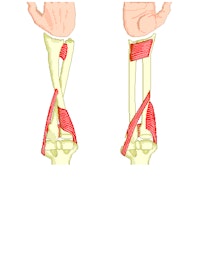Forearm Motion: Pronation, Supination & Body Mechanics
Explore pronation and supination, forearm and hand motions, and their anatomy. Learn about muscles, bones, and joints with Innerbody's educational guide.

Pronation and supination are a pair of unique movements possible only in the forearms and hands, allowing the human body to flip the palm either face up or face down. The muscles, bones, and joints of the human forearm are specifically arranged to permit these unique and important rotations of the hands.
From the anatomical position, with the arms fully extended to the sides of the trunk and the palms facing forward, pronation is the movement of the hands to turn the palms posteriorly. In other words, pronation involves placing the palms into the prone (face-down) position, like someone would do when looking at the backs of their hands. Two muscles in the forearm, the pronator teres and pronator quadratus, work together to achieve pronation by pulling on the radius bone of the forearm. The radius is specially designed to rotate at the elbow and wrist joints around the other forearm bone, the ulna. During pronation, the distal end of the radius rotates around the ulna from its position on the lateral side of the wrist to the medial side of the wrist. This action turns the hand, wrist, and forearm almost 180 degrees so that the palm faces posteriorly or inferiorly, depending on the position of the arm.
In the anatomical position, with the arms extended to the sides of the trunk and palms facing forward, the arms are already in the supinated position. The motion of supination turns the palms anteriorly or superiorly to the supine (face-up) position. Another way of thinking about supination is how someone would move their hands to look at their palms or to hold a bowl of soup. The supinator muscle of the forearm and the biceps brachii of the upper arm supinate the forearm by pulling on the radius. These muscles rotate the radius in the opposite direction of the pronator muscles, moving the distal end of the radius back to its position on the lateral side of the wrist. Full supination moves the hand, wrist, and forearm almost 180 degrees so that the palm faces anteriorly or superiorly, depending on the position of the arm.


